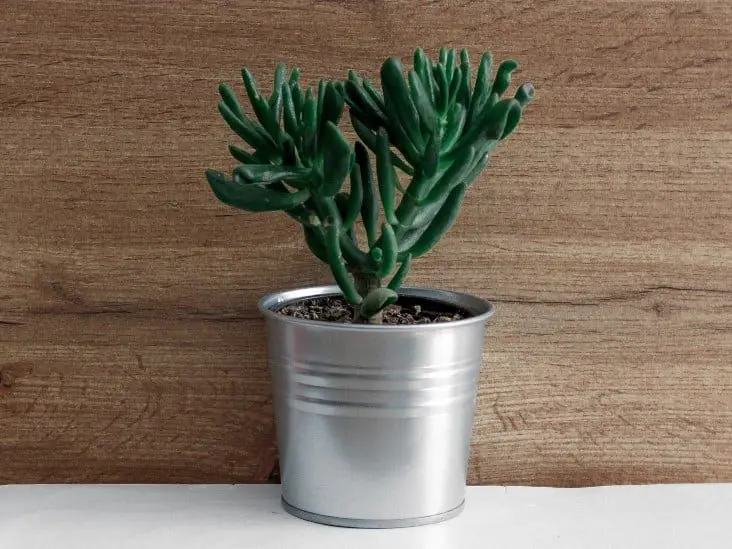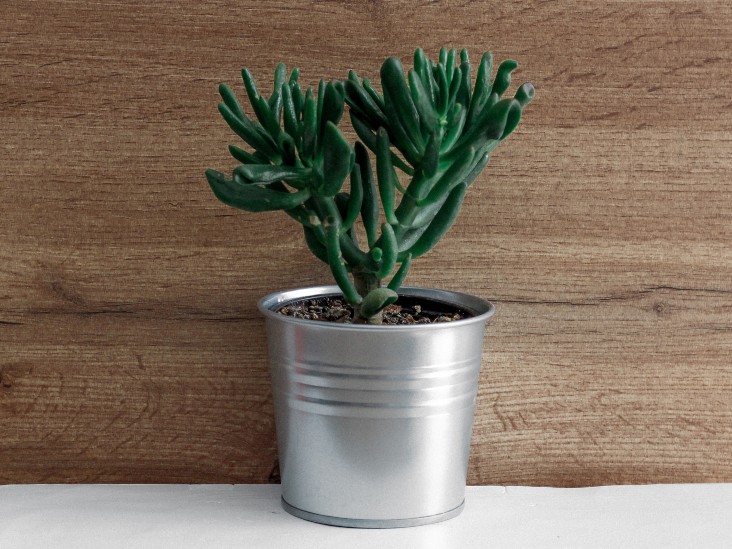8-Golden-Rules-For-Watering-A-Jade Plant

If you want your jade plant to stay healthy and thrive, there are eight golden rules you should follow when watering it. First, always use room temperature water instead of cold or hot water. Second, make sure the pot has drainage holes so that the roots don’t sit in water and rot.
Third, only water your plant when the soil is dry to the touch. Fourth, give your plant a deep watering rather than frequent shallow waterings. Fifth, fertilize your jade plant every other month using a balanced fertilizer.
Sixth, if you live in an area with hard water, use distilled or rainwater to prevent mineral buildup on the leaves. Seventh, avoid getting water on the leaves as this can cause leaf spot or fungal diseases. Eighth, if you’re going on vacation, ask a friend or neighbor to water your jade plant while you’re gone.
Following these eight simple rules will help ensure that your jade plant stays healthy and beautiful for many years to come!
If you have a jade plant, or are thinking about getting one, congratulations! These beautiful and unique plants make great houseplants. But like all plants, they need the right care to thrive.
Here are 8 golden rules for watering a jade plant:
1. Water your jade plant when the soil is dry to the touch. Don’t let it get too dry, or the leaves will start to drop off.
2. Use room temperature water for watering. Cold water can shock your plant and cause leaves to drop off.
3. Water your jade plant slowly and evenly, until water comes out of the drainage holes in the bottom of the pot.
Then stop! Over-watering can lead to root rot, so it’s important not to water too much.
4. After watering, empty any leftover water from the saucer under the pot so that your plant isn’t sitting in wetness for long periods of time.
Wet feet is a sure way to kill a jade plant!
5. Jade plants like bright light but can tolerate some direct sunlight (unlike many other houseplants). If you notice that your plant is starting to stretch out and become leggy, it’s probably not getting enough light and you’ll need to move it closer to a window.
How Much Water Does a Jade Plant Need
Jade plants are beautiful, succulent houseplants that are easy to care for. They are native to South Africa and thrive in dry, warm climates. Jade plants need very little water and can go weeks without being watered.
When watering a jade plant, be sure to use room temperature water and only water the soil, not the leaves. Water the plant thoroughly, then allow the soil to dry out completely before watering again. Jade plants do best in bright, indirect light but can tolerate some direct sun.
If your jade plant is looking leggy or stretched out, it probably needs more light. Jade plants are susceptible to mealybugs and scale insects, so be sure to check your plant regularly for pests.
Ice Jade Price
Hello, everyone! Today, I would like to talk about the price of Ice Jade.
First of all, what is Ice Jade?
It is a kind of jade that has a milky white color with a hint of blue. It is also known as “water jade” because its color is similar to that of water.
Ice jade is very rare and it is said that there are only a few pieces in the world.
As you can imagine, such rarity comes at a high price. The average price of ice jade per carat is around $3,000. However, depending on the quality and size of the stone, the price can go up to $10,000 per carat!
If you are interested in buying ice jade jewelry or sculptures, be prepared to pay a hefty price tag. But if you are lucky enough to own a piece of this beautiful stone, you can be sure that it will become one of your most prized possessions.
How to Make a Jade Plant Fuller
If you have a jade plant that’s looking a little sparse, there are some easy things you can do to make it fuller and healthier. First, check the soil and make sure it’s not too dry – jade plants need to be kept moist but not soggy. If the soil is dry, water your plant and wait a few days to see if it perkS up.
If the soil is wet or mushy, however, it’s best to let it dry out before watering again.
Next, take a look at your jade plant’s leaves. If they’re yellow or brown, that’s an indication that the plant isn’t getting enough light.
Move it to a brighter spot and see if that makes a difference. Jade plants also benefit from being fertilized every few months – use a general purpose fertilizer diluted to half strength and apply it according to package directions.
With just a little TLC, your jade plant will soon be looking full and lush!
Jade Plants Care
Jade plants are beautiful, easy-to-care-for houseplants that can live for decades with proper care. Here are some tips to keep your jade plant healthy and looking its best:
Light: Jade plants prefer bright, indirect sunlight.
If they don’t get enough light, they will become leggy and produce fewer leaves. Too much direct sun will scorch their leaves.
Water: Allow the soil to dry out completely between watering.
Water less in winter when the plant is dormant. Overwatering is the most common cause of death for jade plants.
Soil: Use a well-draining potting mix formulated for cacti and succulents.Regular potting soil retains too much water and will kill your jade plant.
Fertilizer: Feed your jade plant once a month in spring and summer with a balanced fertilizer diluted to half strength. Don’t fertilize in fall and winter when the plant is dormant.
Pruning: Jade plants can be pruned to control their shape and size.
Prune off any dead or diseased leaves or stems as soon as you see them.
Repotting Jade Plant
Jade plants are beautiful, easy-to-care-for houseplants that can live for decades with the proper care. Though they’re tolerant of neglect, they will grow best if they’re repotted every two to three years using a well-draining potting mix.
Here’s a step-by-step guide to repotting your jade plant:
1. Water your jade plant thoroughly a few days before you plan to repot it. This will help make the roots easier to work with.
2. Choose a pot that is only one or two sizes larger than the current pot.
A pot that is too large will result in too much soil and not enough room for the roots, which can lead to problems with drainage and overwatering.
3. Place some of the well-draining potting mix into the new pot and gently remove your jade plant from its current pot. Be careful not to damage the roots as you do this.
4. Place the jade plant in the new pot and fill in around it with more of the potting mix, tamping it down lightly as you go so there are no air pockets. Water thoroughly immediately after planting.
Variegated Jade Plant
Jade plants are a species of succulent plant that is native to South Africa. They are also known as the “money plant” or “lucky plant.” The jade plant has thick, glossy leaves that are variegated with white or yellow.
The jade plant is an easy-to-care-for houseplant and can tolerate neglect. It is a popular choice for bonsai.

Credit: twitter.com
How Should Jade Plants Be Watered?
Jade plants are succulents, so they don’t need a lot of water. In fact, you should err on the side of too little water rather than too much. Water jade plants once every two to three weeks during the growing season (spring and summer), and cut back to once a month in fall and winter.
When you do water, make sure to thoroughly soak the soil until water runs out of the drainage holes at the bottom of the pot. Allow the plant to dry out completely before watering again.
Should Jade Plants Be Watered from the Bottom?
Jade plants are succulents, so they don’t need a lot of water. You can water them from the bottom by putting them in a saucer of water and letting the plant soak up the water it needs. Or, you can water them from the top by watering the soil around the plant.
Whichever way you choose to water your jade plant, make sure that the pot has drainage holes so that any excess water can drain out.
How Do I Make My Jade Plant Happy?
If you’re looking to add a little greenery to your home, a jade plant is a great option. Not only are they attractive and low-maintenance, but they’re also said to bring good luck. Here are some tips on how to keep your jade plant happy and healthy:
Jade plants prefer bright, indirect light. If you can provide them with a spot near a south- or west-facing window, that’s ideal. However, if you live in a hot climate, it’s important to make sure the plant doesn’t get too much direct sunlight, as this can scorch the leaves.
Water your jade plant when the top inch or so of soil is dry. Allow the water to thoroughly soak through the potting mix, then empty out any excess water that remains in the saucer beneath the pot. Jade plants are drought tolerant, so err on the side of underwatering rather than overwatering.
Feed your jade plant once every two months during its growing season (spring and summer), using an all-purpose fertilizer diluted by half. In fall and winter, you can reduce feeding to once every four months or even skip it altogether.
To encourage bushy growth, pinch back new growth regularly.
This will also help keep your jade plant compact and manageable in size.
Does Jade Like to Be Misted?
There is no one-size-fits-all answer to this question, as jade plants can have different preferences depending on their individual needs. However, in general, most jade plants enjoy being misted with water, as it helps to keep them hydrated and also provides them with essential nutrients. If you are unsure whether your jade plant likes being misted, it is best to ask a professional or consult with an expert before doing so.
58/100 Shrek's ears Horseshoe Succulent | Crassula Ovata Gollum Jade • A cultivar of Jade Plant
Conclusion
If you’re one of those people who just can’t keep plants alive, don’t give up hope! The jade plant is a great option for anyone looking for an easy-to-care-for houseplant. Here are eight golden rules for watering your jade plant:
1. Water your jade plant when the soil is dry to the touch. This usually means watering once every 1-2 weeks.
2. Use room temperature water or rainwater if possible.
Cold water can shock the roots and cause leaf drop.
3. Avoid getting water on the leaves, as this can lead to fungal diseases. Water only the base of the plant, not the leaves.
4. Let the water drain completely before putting the plant back in its pot or saucer. Jade plants don’t like to sit in wet soil for long periods of time.